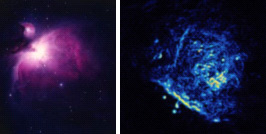Lessons Overview : The Birth of Stars
Dense clouds of gas and dust in outer space are called nebulae (singular: nebula). Over many millions of years, the molecules and dust particles that form nebulae float close enough together to become gravitationally attracted to one another and form larger particles of dust. This process is called accretion. These larger particles rotate through space and continue to accrete more and more mass until an extremely massive object, called a protostar, is created. Even after the dust reaches the stage of protostar, it continues to accrete matter until its mass and rotation cause the density to be high enough to begin nuclear fusion in the core. Once fusion begins, the protostar ignites into a full-fledged star, radiating energy out into the universe.Optical astronomers can observe these clouds of gas and dust from Earth, but have difficulty observing the processes going on inside the clouds because the dust particles block visible light.
Radio astronomers, however, can make clear observations of the processes occurring deep within these clouds because the radio waves emitted pass straight through the intervening gas and dust. Radio astronomers can make observations about the compositions of these stellar nurseries and predict the types of stars they might become long before optical astronomers can study them.
Orion Nebula in optical and radio

NOAO / AURA / NSF

NOAO / AURA / NSF